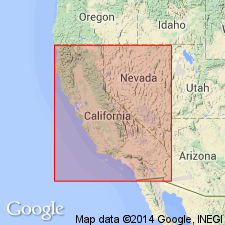
- Usage in publication:
-
- Phoenix member
- Modifications:
-
- Named
- Biostratigraphic dating
- Dominant lithology:
-
- Sandstone
- Siltstone
- Mudstone
- AAPG geologic province:
-
- California Coast Ranges province
Summary:
Pg. 58 (fig. 7), 60-61 (table 2), 62, figs. 5, 6, map 1. In Phoenix-Saucelito Creeks area of south-central part of San Luis Obispo County, California, Phoenix member is named as middle member of Santa Margarita formation. Consists of sandstone or siltstone alternating with siliceous mudstone. Sandstone is fine- to coarse-grained arkosic or quartz arenite, locally containing much shell debris. Siltstone and mudstone locally contain abundant PECTEN DISCUS remains. Composite columnar section and geologic map show unit is divided into 5 lithologic units of approximately 3,000 feet total thickness. Overlies Huasna member (new); underlies Saucelito member (new) (both of Santa Margarita formation). Age is late Miocene based on megafossils which are listed.
Type locality not designated. Origin of name not stated. Occurs in Phoenix-Saucelito Creeks area of south-central part of San Luis Obispo Co., CA.
[Author does not capitalize rank terms; however, units are considered formal.]
Source: GNU records (USGS DDS-6; Menlo GNULEX); US geologic names lexicon (USGS Bull. 1350, p. 573-574).
For more information, please contact Nancy Stamm, Geologic Names Committee Secretary.
Asterisk (*) indicates published by U.S. Geological Survey authors.
"No current usage" (†) implies that a name has been abandoned or has fallen into disuse. Former usage and, if known, replacement name given in parentheses ( ).
Slash (/) indicates name conflicts with nomenclatural guidelines (CSN, 1933; ACSN, 1961, 1970; NACSN, 1983, 2005, 2021). May be explained within brackets ([ ]).

